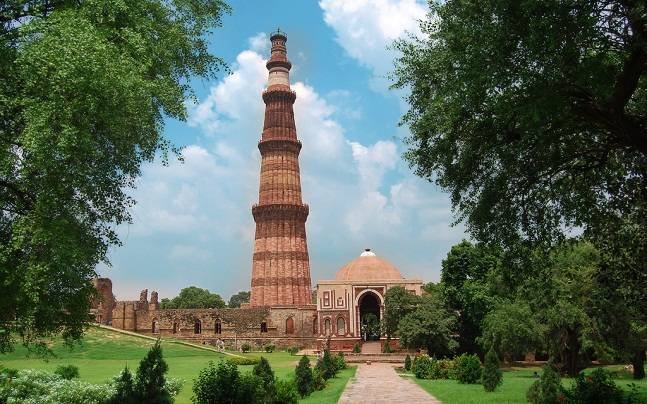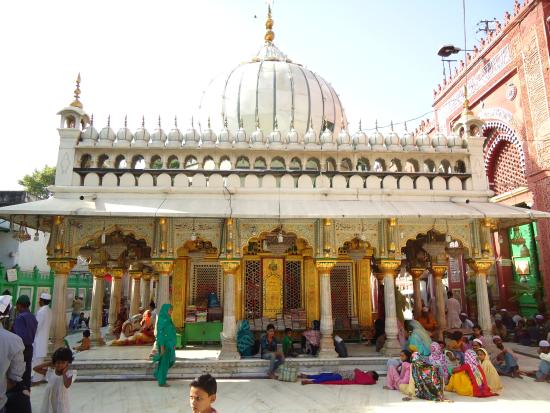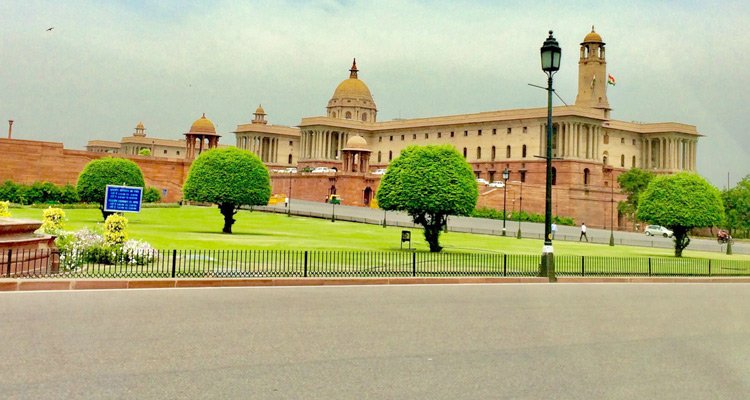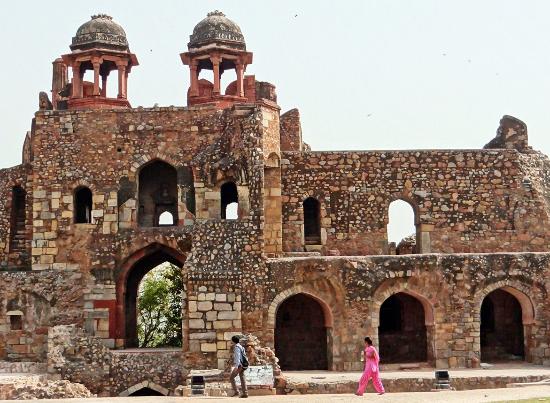Architectural Heritage of Delhi
Delhi is not just the current capital of the country. Throughout several centuries in the past, Delhi has been a site of political importance. Due to its strategic location and cultural beauty, many rulers and invaders wanted to make Delhi, their own. Many such rulers managed to captured Delhi or parts of Delhi and build many structures, temples, places of interest and others to mark their territory and also to create a name in the history. Today, Delhi’s tourism depends a lot on these structures.
Delhi is simply a magnificent destination of culture, heritage and architecture, starting from Qutub Minar to India Gate, the place as a lot of history and culture embedded in the architectural beauties of the land. Here are the top 12 structures to visit in Delhi.
Famous Architectural Heritage Structures in Delhi
1. Qutub Minar
 This is one of the earliest and most famous Indo-Muslim structures of the land. This structure was built 10,000 years ago with a minaret, which was 72.5m tall with 379 steps using red sandstone. King Qutb-ud-din Aybad wanted to celebrate the expansion of Islam territory in India by building the tallest minaret of that time period. This heritage site is also famous for the carved designs and the grand structure.
This is one of the earliest and most famous Indo-Muslim structures of the land. This structure was built 10,000 years ago with a minaret, which was 72.5m tall with 379 steps using red sandstone. King Qutb-ud-din Aybad wanted to celebrate the expansion of Islam territory in India by building the tallest minaret of that time period. This heritage site is also famous for the carved designs and the grand structure.
2. Lodhi Garden
 Delhi is the Land of Concrete Jungle. However, there are a few places lush with foliage in this city too. One such ancient garden-turned-modern-park is the Lodhi Garden, which is filled with Mughal era tombs, ancient structures and much more. The entire area is spread with lush vegetation for people to relax, explore and enjoy.
Delhi is the Land of Concrete Jungle. However, there are a few places lush with foliage in this city too. One such ancient garden-turned-modern-park is the Lodhi Garden, which is filled with Mughal era tombs, ancient structures and much more. The entire area is spread with lush vegetation for people to relax, explore and enjoy.
3. Red Fort
 Of all the heritage structures of this land, the most visited and still-politically influenced structure is the grand Red Fort. This 17th century fort of Mughal was a creative structure and the second most daring architecture commissioned by Shah Jahan. This structure gets its name from the thick red sandstones used for the construction. The architecture is a mixture of European, Persian and Indian style. Inside the fort, you can find many monuments like Rang Mahal, Mumtaz Mahal, Diwan-i-Khas, Diwan-i-Am, Khas Mahal, Shah Burj, Hamam and others.
Of all the heritage structures of this land, the most visited and still-politically influenced structure is the grand Red Fort. This 17th century fort of Mughal was a creative structure and the second most daring architecture commissioned by Shah Jahan. This structure gets its name from the thick red sandstones used for the construction. The architecture is a mixture of European, Persian and Indian style. Inside the fort, you can find many monuments like Rang Mahal, Mumtaz Mahal, Diwan-i-Khas, Diwan-i-Am, Khas Mahal, Shah Burj, Hamam and others.
4. Hazrat Nizamuddin Dargah
 This 14th century mausoleum belongs to the famous Sufi Saint Hazrat Nizamuddin Auliya. This Dargah is an important Muslim pilgrimage and a grand heritage of the city. This holy site is located on top of an ancient tank. This site is surrounded by many other tombs. You can also find a small bazaar road closer to the entrance of this Dargah.
This 14th century mausoleum belongs to the famous Sufi Saint Hazrat Nizamuddin Auliya. This Dargah is an important Muslim pilgrimage and a grand heritage of the city. This holy site is located on top of an ancient tank. This site is surrounded by many other tombs. You can also find a small bazaar road closer to the entrance of this Dargah.
5. Humayun's Tomb
 This structure is the resting place of Humayun, a grand Mughal Emperor. This structure gets its fame for being the inspiration for the World Wonder, Taj Mahal. This tomb has large gardens with a central structure of mausoleum. This structure is the best example for Persian styled Mughal architecture. It was built in 16th century by Humayun’s first wife Hamida Banu Begum. This is also the first large sandstone mausoleum. Apart from the main tomb, you can find various other monuments and structures inside the complex.
This structure is the resting place of Humayun, a grand Mughal Emperor. This structure gets its fame for being the inspiration for the World Wonder, Taj Mahal. This tomb has large gardens with a central structure of mausoleum. This structure is the best example for Persian styled Mughal architecture. It was built in 16th century by Humayun’s first wife Hamida Banu Begum. This is also the first large sandstone mausoleum. Apart from the main tomb, you can find various other monuments and structures inside the complex.
6. Jama Masjid
 This is the second largest mosque of the country and one of the oldest ones too. This mosque is also called as the Masjid-i-Jahan-Numa. This mosque is a heritage beauty and an architectural marvel. The way to the mosque is filled with bazaars and mansions to enjoy the cultural life of the region. The primary structure of the mosque is the mosque of Shah Jahan, which is built in marble and sandstone. The interior walls are decorated with black stripes.
This is the second largest mosque of the country and one of the oldest ones too. This mosque is also called as the Masjid-i-Jahan-Numa. This mosque is a heritage beauty and an architectural marvel. The way to the mosque is filled with bazaars and mansions to enjoy the cultural life of the region. The primary structure of the mosque is the mosque of Shah Jahan, which is built in marble and sandstone. The interior walls are decorated with black stripes.
7. Jantar Mantar
 Jantar Mantar of Jaipur is an important tourist attraction. There are five similar Jantar Mantars and one of them is located in Delhi. Jantar Mantar is an astronomic structure filled with ancient instruments for calculating astronomical movements. The observatory had the most outstanding technologies during the time of its inauguration. This structure is considered as an important part of scientific heritage of the land.
Jantar Mantar of Jaipur is an important tourist attraction. There are five similar Jantar Mantars and one of them is located in Delhi. Jantar Mantar is an astronomic structure filled with ancient instruments for calculating astronomical movements. The observatory had the most outstanding technologies during the time of its inauguration. This structure is considered as an important part of scientific heritage of the land.
8. Lotus Temple
 This is an innovative religion-less temple. This majestic temple is built in a shape of a lotus, which is about to be blossomed. The temple is surrounded by grasslands, ponds, gardens and more. The structure is built with 27 giant slabs of marbles resembling the petals of the flower.
This is an innovative religion-less temple. This majestic temple is built in a shape of a lotus, which is about to be blossomed. The temple is surrounded by grasslands, ponds, gardens and more. The structure is built with 27 giant slabs of marbles resembling the petals of the flower.
9. India Gate
 The India Gate is a structure that represents bravery and an important war memorial for the soldiers of World War. This structure was built in 1931 and a flame is always lit under the gate as an honor to all the soldier who laid down their lives during the war. This region is an important picnic spot and a marvelous architectural beauty.
The India Gate is a structure that represents bravery and an important war memorial for the soldiers of World War. This structure was built in 1931 and a flame is always lit under the gate as an honor to all the soldier who laid down their lives during the war. This region is an important picnic spot and a marvelous architectural beauty.
10. Rashtrapati Bhavan
 Rashtrapati Bhavan is a grand political structure, which is now the official home of President of the country. This structure was built by Sri Edwain Lutyens as the building structure of central power in British controlled India. Today, tourists visit this structure to enjoy manicured gardens, corridors, Lutyens’ Galley, Ashoka Hall, Children’s Galley, Gift museum, Durbar Hall and others.
Rashtrapati Bhavan is a grand political structure, which is now the official home of President of the country. This structure was built by Sri Edwain Lutyens as the building structure of central power in British controlled India. Today, tourists visit this structure to enjoy manicured gardens, corridors, Lutyens’ Galley, Ashoka Hall, Children’s Galley, Gift museum, Durbar Hall and others.
11. Purana Quila
 This is one of the oldest forts of Delhi. This structure is linked with the legendary characters of Mahabharata. The fort ias believed to be built by the Pandava brothers. From tourist point of view, the fort has a grand look, sturdy structure and a few Mughal features as it was renovated by Humayun, many centuries later. Today, the fort stands as a structure of marble and sandstone rising to a height of 60 feet from ground.
This is one of the oldest forts of Delhi. This structure is linked with the legendary characters of Mahabharata. The fort ias believed to be built by the Pandava brothers. From tourist point of view, the fort has a grand look, sturdy structure and a few Mughal features as it was renovated by Humayun, many centuries later. Today, the fort stands as a structure of marble and sandstone rising to a height of 60 feet from ground.
The fort has three main gates. The structure has many eminent architectural elements that represent the craftsmanship of each era. Apart from these, the fort is very famous for the Sound and Light Show, which takes place every evening. The show takes you through the 5000 years of history of Delhi region. There is a small lake closer to the fort, which is open for boating.
12. Tughlaqabad Fort
 This was once a grand fort, which now stands as a ruined reminder of Tughlaq Dynasty. This 14th century fort was once the main political structure of historic Delhi. The fort was abandoned and the region was conquered by other dynasties. The main purpose of this sturdy fort on a small hillock was to protect the region from invading Marauders.
This was once a grand fort, which now stands as a ruined reminder of Tughlaq Dynasty. This 14th century fort was once the main political structure of historic Delhi. The fort was abandoned and the region was conquered by other dynasties. The main purpose of this sturdy fort on a small hillock was to protect the region from invading Marauders.
The fort is completely made with granite and lime mortar. The fort is connected to the mausoleum of Ghiyath-al-Din Tuqhluq via a causeway. This causeway was built over an artificial lake. The walls of the tomb are granite and the mausoleum is made with sandstone with marble decorate. There are three graves inside the mausoleum.
The granite fortification over rugged landscape is a striking feature of Tughlaq style architecture. Today, most of this fortified city is off-limits for tourists. However, you can spot many structures today like Bijai Mandal, palace area, underground passage, water reservoir and others.
